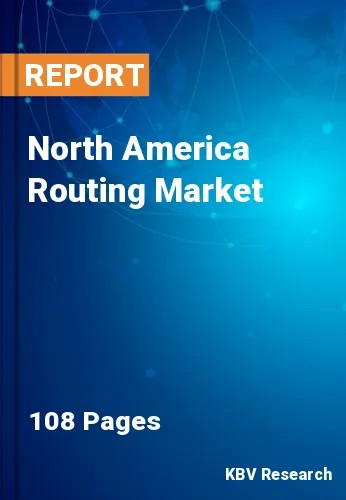The North America Routing Market would witness market growth of 6.3% CAGR during the forecast period (2021-2027).
The router chooses the paths for Internet Protocol (IP) packets to go from their origin to their destination, which is a key aspect of the internet. A router's routing function normally directs forwarding based on routing tables, which keep track of all the routes to different network destinations. A routing table is comparable to a train timetable, which passengers study to determine which train to board. Routing tables work in a similar way to train schedules, but for network paths rather than trains. Moreover, these tables can be established by an administrator, learned by network traffic analysis, or generated using routing protocols.
Routing relates to IP routing and is compared with bridging. Additionally, IP routing supposes that network addresses are organized and that comparable addresses indicate network proximity. Moreover, a single routing table item can indicate the route to a collection of devices using structured addresses. Structured addressing (routing in the restricted sense) surpasses unstructured addressing in big networks (bridging).
According to internetworldstats, around 90.3 percent of the population in North America has internet connection. This reflects the region's heavy reliance on the internet for a variety of tasks, including using social media platforms, consuming video material on OTT and other platforms, and performing other tasks that necessitate a constant internet connection. The United States, Canada, and Mexico are three of the region's most important countries, and they are likely to play a significant role in the region's growth. Moreover, regional governments have been constantly increasing their investments in broadband services, demand for wireless hotspots and Wi-Fi solutions and services. Following the terrorist attacks of September 11, 2001, governments across North America have taken considerable steps to improve public safety by investing in broadband technologies.
The US market dominated the North America Routing Market by Country in 2020, and would continue to be a dominant market till 2027; thereby, achieving a market value of $5,587.3 Million by 2027. The Canada market is estimated to grow at a CAGR of 8.7% during (2021 - 2027). Additionally, The Mexico market would showcase a CAGR of 7.8% during (2021 - 2027).
Based on Type, the market is segmented into Wireless and Wired. Based on Placement, the market is segmented into Edge, Core, and Virtual. Based on Application, the market is segmented into Enterprise and Datacenter. Based on Vertical, the market is segmented into BFSI, Healthcare, Education, Residential, Media & Entertainment, and Others. Based on countries, the market is segmented into U.S., Mexico, Canada, and Rest of North America.
Free Valuable Insights: The Global Routing Market is Estimated to reach $22.7 Billion by 2027, at a CAGR of 7.8%
The market research report covers the analysis of key stake holders of the market. Key companies profiled in the report include Arista Networks, Inc., New H3C Technologies Co., Ltd., Xiaomi Corporation, Cisco Systems, Inc., Juniper Networks, Inc., Huawei Technologies Co., Ltd., Nokia Corporation, ASUSTeK Computer, Inc., Netgear, Inc., and Hewlett-Packard Enterprise Company.
By Type
By Placement
By Application
By Vertical
By Country
Our team of dedicated experts can provide you with attractive expansion opportunities for your business.

